The Heraldry
of Sewell
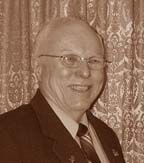
This page was
set up by Robert Sewell in November, 2002 to show the history of the Heraldry
of the Sewell / Sewall Family since the earliest known times. Robert
Sewell graduated from McMaster University (Hamilton, Ontario, Canada) in
1967 with a B.Sc. degree in chemistry. After a year of studies at
the University of Toronto's College of Education, he taught high school
science in Collingwood, Ontario for a year and then taught chemistry, physics
and general science in Hamilton, Ontario for twenty-nine years. Robert
Sewell retired from teaching in June 1998.
Click
to contact Robert Sewell
Please visit the Sewell
Genealogy Site Map for other pages in this series.
The information presented has been
taken from the following sources:
-
Stephen L. Sewell, Letter
posted at Genealogy.com, 2002. At a cost of £150, Mr. Sewell
had a written report prepared by Mr. Patric L. Dickinson, Richmond Herald
of the Royal College of Arms. This report is dated August 31, 2000.
Many thanks to Mr. Stephen L. Sewell of Aberdeen, Maryland for sharing
this information.
-
A.C. Fox-Davies & J.P. Brooke-Little:
A
Complete Guide to Heraldry, London 1985
-
Sir
Hector Livingston Duff: The Sewells in the New World,
Exeter 1924
-
{Professor}
Edward Elbridge Salisbury: Family Memorials, privately
printed in 1885
-
{Rev}
Henry Doyle Sewell (1806 - 1886): Letters,
unpublished.
-
Richard Thomson, An Historical
Essay on the Magna Charta of King John, London 1829
Bees in Heraldry
"The insect which is most usually met with in heraldry
is undoubtedly the bee. Being considered, as it is, the symbol of
industry, small wonder that it has been so frequently adopted. . . .
"It occurs in the arms of . . . Sewell . . .."
....Fox-Davies, A Complete Guide to Heraldry, page
195
The earliest mention that I could find of bees in heraldry
is in the arms of Thomas Muschamp (Azure, 3 bees, 2 and 1, Or) on page
274 of Richard Thomson's An Historical Essay on the Magna Charta
of King John. Thomas Muschamp is described as a "baron of the reigns
of John, Henry III and Edward I"; i.e., during the 13th century. |
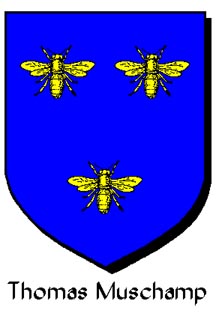 |
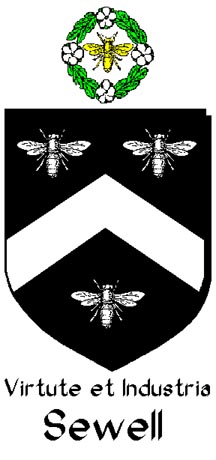
The arms claimed and borne for centuries by the Sewells of New England,
and by their ancestors in the United Kingdom, are: "Sable, a chevron between
three bees volant, argent"; their crest being: "Within a chaplet
of roses, argent, leaved vert, a bee Or."(1) A
seal bearing these arms was brought to Massachusetts by {Rev}
Henry Sewall in 1634. This seal is now in the possession of the
Durnford Family of Montreal who are descendants of Solictor
General Stephen Sewell (1770 - 1832). The Sewells claim that these
arms belonged to their ancestors before the founding of the College of
Heralds in 1483:
-
According to the Dictionary
of British Arms - Mediæval Ordinary Volume Two these arms are listed
as registered to Henry Sewelle in 1405 and listed in 1415. Unfortunately
in 1415 — the second time we see the arms of Henry Sewelle appear — a dictum
was sent out by Henry V that only the "arms which were borne at Agincourt"
would be registered by the heralds, unless the bearer could show a long
and valid right to those arms. It appears that Henry did not persue
the matter, and the arms were not patented by the Heralds of the College
of Arms (2).
-
Fuller, in his Worthies
of England (vol i, p. 533), mentions John Sewell, Sheriff of Essex,
in 1382, gives his arms as "Sable, a chevron between three gadde-bees,
argent."(3).
-
Fuller, in his List
of Sherriffs, mentions John Seawale Sheriff of Essex and Hertfordshire,
4th Richard A.D. 1380 whose arms he describes as "Sable à Cheveron
betwixt 3 Gadd Bees Argent"(4).
-
Lysons, in his History of Bedfordshire
(p. 107) states there is an ancient monument in the church of Houghton
Regis, near Dunstan, Bedfordshire with the effigies of a man in armour
under a rich Gothic arch which had the arms of Sewell — a Cheveron between
3 butterflies. This monument has been personally inspected
by my greatX2 grandfather, {Rev}
Henry Doyle Sewell of Headcorn, Kent, who states that Lysons evidently
mistook the bees for butterflies as the monument had been "strongly defaced
with whitewash and mutilated".(5)
Despite the foregoing,
and despite the fact that the archives of the Heralds' College contain
several Sewell coats in which flying bees appear, the bearings described
are shown as having been originally recorded at the College by Nicholas
Girlington, of York, in 1563. While the Sewell Family claims that
the College has made a mistake, it must be borne in mind that:
-
Our earliest Sewell ancestor who can
be traced with certainty is William Shewell of Warwickshire who married
Matilda Horne in 1540. Some claim he was a lineal descendant of the knights
and gentlemen of his name who bore the silver bees and chevron on the black
shield, and it may be that he was; but sufficient evidence is lacking.
-
The Sewells could have, and should
have, protested the patenting of these arms by Nicholas Girlington in 1563;
but did not. However, in 1638, John Gwillim, Rouge
Croix Pursuivant, in a heraldic treatise, makes this explicit statement:
"SEWELL: He beareth three bees volant."(6)
According to an 1899 pedigree held by the Virginia Historical Society in
Richmond, Virginia, USA, the following arms are associated with the Sewells
of Coventry and New England and date from 1540 or earlier: "Sable,
a chevron Or between three gaddbees volant Argent."(7)
The earliest reference
I have been able to find to this coat (with the gold chevron) is in Professor
Salisbury's Family Memorials(8). Quoting correspondence
with Mrs. Philip Durnford of Montreal (née Augusta Sewell, my greatX2
grandfather's cousin), Professor Salisbury writes:
"According to this lady's description
of the arms, the chevron is Or, there is a crest consisting of a
wreath surrounding a bee volant (see Burke's General Armory, ed. 1878,
p. 914), and there are roses depicted at the lower corners of the shield
which are said to have been permitted to be worn as a reward for some deed
of valour, performed by an ancestor fighting on the side of Lancaster during
the War of the Roses" (9)
Presumably, the
roses alluded to above would be the red rose of the House of Lancaster,
as opposed to the roses argent (the white rose of the House of York)
mentioned in the crest of the Arms of Sewell. However, this aside,
Professor Salisbury also writes (with no mention of the chevron Or):
". . .
the indisputable fact that certain arms — namely: Sa. a chevr. betw. three
bees volant Arg., have been handed down by painting, tradition or otherwise,
among the Sewalls now known to reside in New England and Lower Canada .
. .." (10)
A tablet was erected in Trinity Church, St. John, New Brunswick in memory
of Jonathan Sewall and Esther Quincy by Edward Comyns Durnford (1844 -
1927, my great grandfather's second cousin). This tablet does not
show a differentiation between the tinctures of the coat of arms.
Please click HERE
to view this tablet.
Thus, the Sewalls
and Sewells of New England and Canada are left with a choice of silver
(Argent) or gold (Or) for the chevron, as shown in the following drawings:
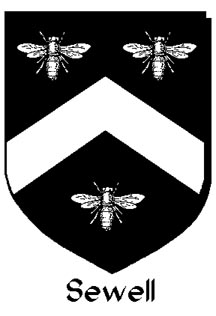
|
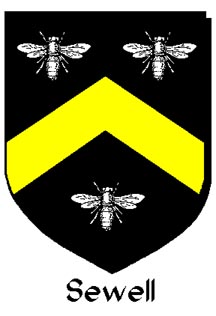
|
The arms claimed and borne for centuries
by the Sewells of New England, and by
their ancestors in the United Kingdom, are:
Sable, a chevron between
three bees volant, Argent
|
According to the Edward Elbridge Salisbury,
the arms associated with the Sewells
of Coventry and New England are:
Sable, a chevron Or between
three gadbees volant Argent.
|
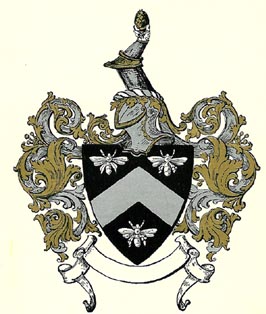 |
In Memory of
Roy Brown Sewell, Sr.
of Georgia and Alabama
This beautiful Coat of Arms, described as:
"Sable, a chevron between three bees volant argent. Crest
—
A dexter arm embowed in armour proper garnished or, holding an acorn gold"
has been shared through the courtesy of
Mr. C. M. Wright of Oklahoma.
Click to send an email to
Mr.
C. M. Wright
|
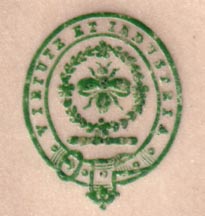 |
John Rees sent the image of this crest along with
the note:
"This little crest came to light amongst
some things of my mother's."
John Rees is my father's second cousin,
our common ancestor being {Rev} Henry Doyle Sewell.
Click on John
Rees for details.
|
Some Sewells
have abandoned their ancient claim altogether, and have obtained fresh
patents of a totally dissimilar kind. The first to do this was Robert
Sewell, the youngest son of John Sewell of Great Henny, Essex, described
as a "Gentleman of His Majesty's Privy Chamber," who in 1667 took a grant
of "Argent, on a bend gules three martlets of the field."(11) For more on this family, please Click Here.
Arms
described as "Ermine on a bend engrailed between two lions rampant Gules
three martlets Argent" were patented by John Goulding Sewell of Scopwick,
Lincolnshire, in May 1843.(12)
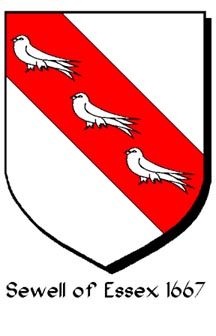
|
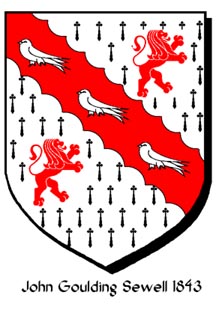
|
Robert Sewell of Essex, 1667
Argent, on a bend gules
three martlets of the field
|
John Goulding Sewell, 1843
Ermine on a bend engrailed between
two lions rampant Gules three martlets
Argent
|
Other Sewells, desiring to retain
in their coats some trace, at least, of the lost bearings of their ancestors,
have accepted patents showing the Sewell bees in different form.
In this group we find:
-
Thomas Davies Sewell of Westminster, London
(with whom I cannot establish a relationship) who patented the arms "Gules,
a pale Argent surmounted by a chevron invected counter-changed between
in chief two escutcheons of the second and in the base one of the first
each charged with a bee volant proper" in October 1867 or 1897(13).
-
Frederick Robertson Sewell of Brandlingill,
Brigham, Cumberland (also with whom I cannot establish a relationship)
who patented the arms "Gules, a chevron between two bees volant proper
and a chaplet of roses in base, Argent" in July 1899(14).
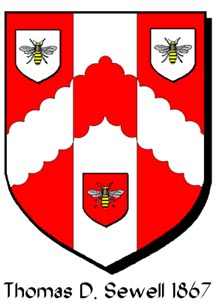
|
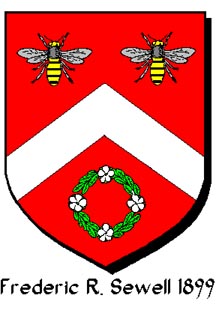
|
Thomas Davies Sewell
Gules, a pale Argent surmounted by a chevron invected counter-changed
between in chief two escutcheons of the second and in the base one of the
first each charged with a bee volant proper
|
Frederick Robertson Sewell
Gules, a chevron between
two bees volant proper and
a chaplet of roses in base, Argent
|
-
Percy
Ambrose Sewell Hickey (my grandfather's second cousin) of Westminster,
London, who was a son of Emily Sewell and Mr. Hickey (described by our
cousin W. Darcy McKeough as "a barrister"), patented the arms "Per chevron
Sable and Vair; three bees volant, Or." in August 1912(15).
-
Horace Somerville Sewell of Tysoe Manor,
Warwickshire (with whom I cannot establish a relationship) who patented
arms "Azure, a chevron engrailed Argent in chief two bees volant proper"
in January 1940.(16)
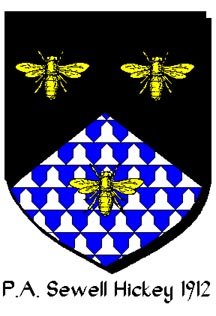
|
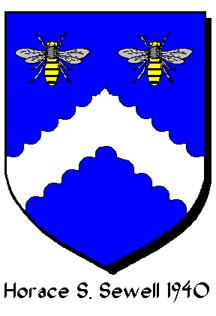
|
Percy Ambrose Sewell Hickey
Per chevron Sable and Vair;
three bees volant, Or
|
Horace Somerville Sewell
Azure, a chevron engrailed Argent
in chief two bees volant proper
|
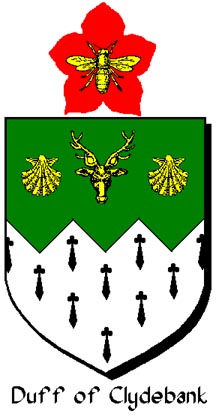 |
Sir Hector Livingston Duff, K.B.E., C.M.G
Knight Commander of the Most Excellent
Order of the British Empire
and
Companion of the Most Distinguished
Order of St. Michael and St. George.
All records indicate that Sir Hector was a "good chap."
Sir
Hector Livingston Duff, son of Alice Sewell (afterwards Lady Russell)
and John Pope Duff of Edderton, Rosshire had title to the Arms of Duff
of Clydebank surmounted by a badge showing the bee of Sewell charged upon
the cinquefoil of Livingston(17).
Sir Hector recorded much of our family history in his
book The Sewells in the New World, Exeter 1924. This
book, along with many others, is available as a reprint from Higginson
Books of Salem, Massachusetts.
Sir Hector was my grandfather's second cousin; their common
ancestor being {Chief
Justice} Jonathan Sewell. |
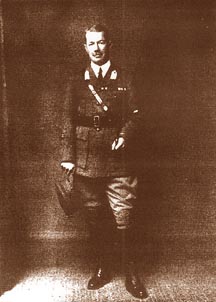
Photo from
The Sewells in the New World
Exeter, 1924
|
Sir Hector
was Chief Secretary to the Governor of Nyasaland. This made him "Number
2" and he would effectively run the country if the Governor was on leave.
He wrote an unpublished book Nyasaland in the World War 1914-18
which is held by the Imperial War Museum in London.
Sir Hector spoke fluent German
and as a result he accompanied the Nyasaland Field Force at the northern
border and fought at the battle of Kasoa in Nyasaland. After the
British invaded German East Africa (Tanganyika) he was made Chief Political
Officer and effectively ran the Govt. of the Occupied Country. He
was awarded his Knighthood for these services. He then suffered some sort
of a breakdown. Colonel Barton speaks highly of him in his unpublished
diaries.
. . . thanks to Peter Charlton who is writing The
Nyasaland Volunteer Reserve. |
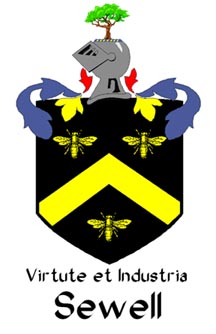
In the middle ages, the right to arms
was jealously guarded, and no person would have dared to use a heraldic
coat without justification, or could have hoped to escape detection and
punishment if he did.
The 2002 cost of patenting a coat of
arms is
£2895, or $4560 American as of November
2002. This is a whopping $7200 Canadian! Fortunately, heraldry is
now considered little more than a hobby, and Robert Sewell
intends to use the arms pictured to the right without bothering to patent
them. (At $7200?? I'm glad I was seated when I figured that
one out!) Thanks to Mark Sewell of Liverpool for the suggestion with
regard to "gold bees"; I think they look better than silver bees.
Thanks to Darren
S. A. George of British Columbia for suggesting that ". . . we have our
own heraldic authority in Canada. This is part of the Governor General's
office . . .." Please visit The
Canadian Heraldic Authority which has a number of options and states
that as of 2005 ". . . the minimum cost of a grant of a coat of arms (shield,
crest, helmet, mantling, and motto) is likely to be around $1,900 . . .."
It appears that various options could double this amount. Be sure
to visit Darren's website which is devoted primarily to Heraldry in Canada:
"The Mad Alchemist's Heraldry"
For further information
on drawing your own arms, check the following links. Remember not
to take any of this too seriously; but please show respect for those who
choose to do so:
Please visit the Sewell
Genealogy Site Map for other pages in this series.
Click to go
back to the top
Footnotes Click on the Footnote
Number to return to your place on the page above.
(1)
Sir Hector Livingston Duff: The Sewells in the New World,
Exeter 1924, page 97
(2)
Stephen L. Sewell, letter,
November 2002
(3)
Sir Hector Livingston Duff, page 99
(4)
{Rev} Henry Doyle Sewell, letter,
February 3, 1858
(5)
{Rev} Henry Doyle Sewell, letter,
February 3, 1858
(6)
Sir Hector Livingston Duff, page 99
(7)
Stephen L. Sewell, letter,
November 2002
(8)
Edward Elbridge Salisbury: Family Memorials, 1885, pages
145 & 165, and pedigree chart.
(9)
Edward Elbridge Salisbury, page 166, footnote.
(10)
Edward Elbridge Salisbury, page 165
(11)
Sir Hector Livingston Duff, page 101
(12)
Stephen L. Sewell, letter,
November 2002
(13) Stephen L.
Sewell states "October 1897" and Sir Hector Livingston Duff states "October
1867".
(14) Sir
Hector Livingston Duff, page 102; Stephen L. Sewell, letter,
November 2002.
(15)
Sir Hector Livingston Duff, page 102 & 103; Stephen L. Sewell, letter,
November 2002.
(16)
Stephen L. Sewell, letter,
November 2002
(17)
Sir Hector Livingston Duff, page 102 & 103
















